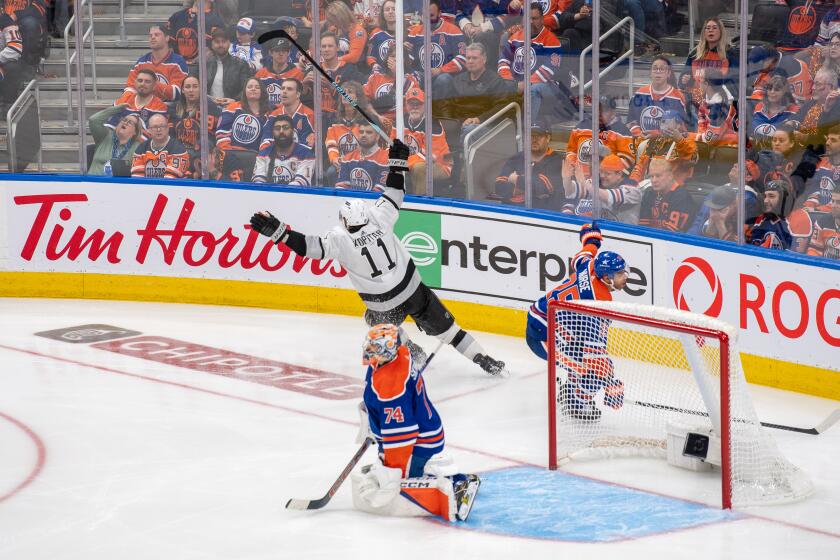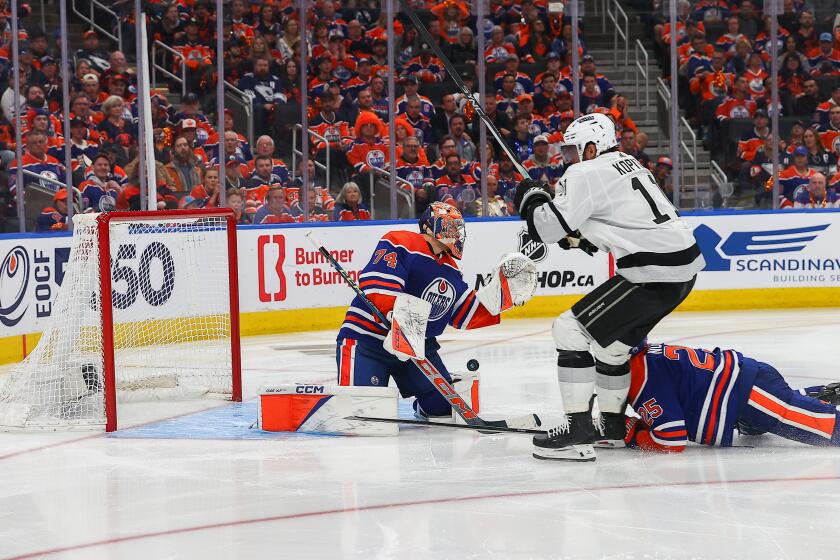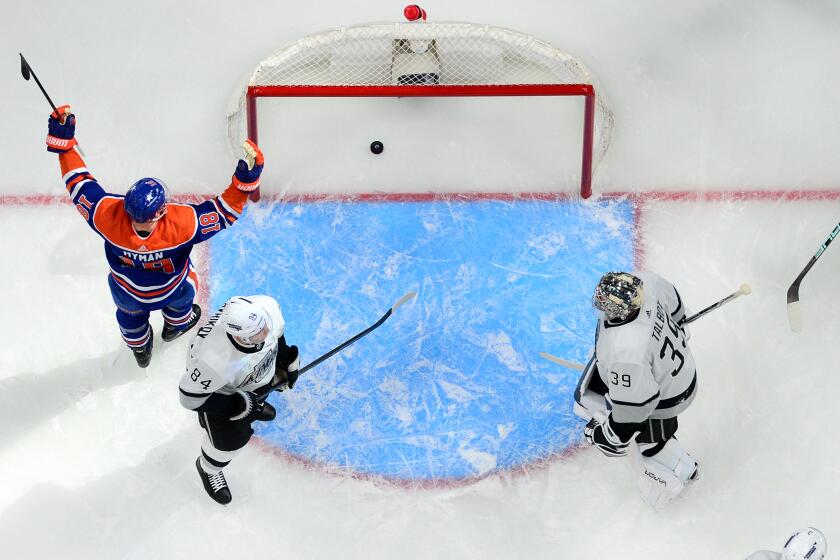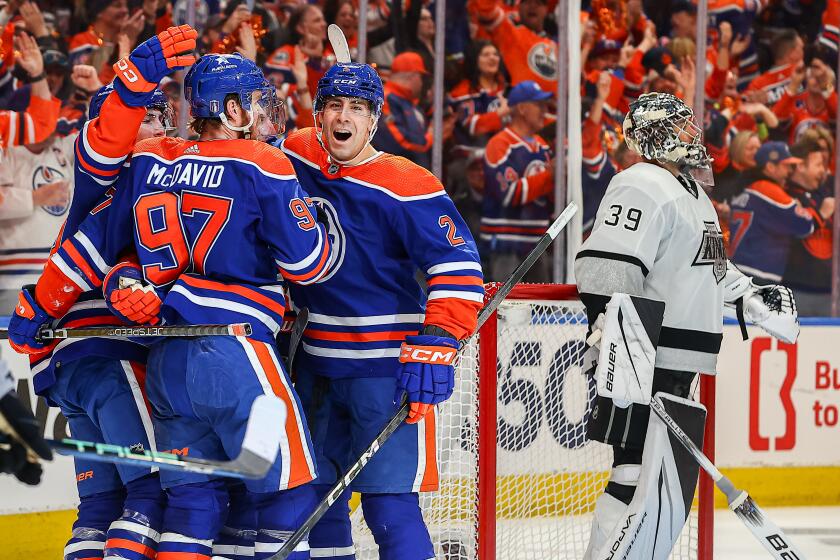Deadmarsh Faces His Reality Check
Adam Deadmarsh answers the phone at his house while his daughter, Alexis, is crying in the background.
“Can you call back in five minutes?” Deadmarsh asks, politely yet urgently. He has to put his twin daughters to bed.
Life goes on for the King power forward, and yet it has changed drastically, possibly forever.
It has been one year since Deadmarsh last played a hockey game. Often referred to as “the heart and soul of the team” by King President Tim Leiweke, Deadmarsh has not skated with contact since being kneed in the head by former teammate Craig Johnson and sustaining a concussion last Dec. 15 in Phoenix.
It was the third career concussion and the second in as many months for Deadmarsh, who has since experienced slight highs and deep lows in his rehabilitation, leading him at times to ponder if he would ever play again.
“When you’ve been out as long as I have, things like that cross your mind,” said Deadmarsh, 28. “I’d be lying if I said it hadn’t. That’s not my plan right now.”
A return after such a layoff would not be unprecedented -- Eric Lindros and Paul Kariya came back from similar situations -- but there are many concussion stories with unhappy endings.
The high-scoring career of Pat LaFontaine ended because of a concussion. Closer to home and more recently, King forward Ken Belanger and Mighty Duck winger Kevin Sawyer had their careers cut short last season because of concussions.
Deadmarsh, a big-bodied player who crashes the net on offense and knocks opponents off the puck on defense, said he was “99% there” in his recovery a week before the Kings’ season began in October. But he never turned the corner and hasn’t skated since colliding with teammate Jozef Stumpel during a Nov. 11 shooting drill with other injured skaters.
The exercise was supposed to be noncontact but, “I didn’t see him coming,” Deadmarsh said. “I was shooting a puck and we were supposed to regroup after we shot it. He was regrouping after he shot it and we just ran into each other. Things like that happen during a practice. Bad luck, I guess.”
Some of Deadmarsh’s worst concussion symptoms returned. He was continually tired. He still strains at time to focus on objects, whether they are contents on a cereal box or laces on his shoes.
“Everything’s more draining on your senses than they should be,” he said. “My vision just doesn’t feel like things are easy for me to focus on.”
King personnel have become well-acquainted with concussion recovery, particularly this year. Deadmarsh is one of four players suffering from concussions or similar ailments: Forwards Ian Laperriere and Esa Pirnes have been out almost three weeks because of concussions, and center Jason Allison has been out since January because of whiplash.
King General Manager Dave Taylor has quietly watched after it became apparent Deadmarsh would not return for the start of the season. Taylor, who played 17 seasons with the Kings, retired in 1994 because of a concussion. He understands the difficulty in coming back from one.
“I probably had symptoms bother me for six months,” Taylor said. “I would turn my head to one side and make the room spin. I’d stand in line at a movie theater and then all of a sudden feel like I’m going to fall. Laying in bed, you get a sensation that you’re falling and you’d be lying right in the middle of the bed.”
Concussions occur when there is sudden movement of the head that causes the brain to shift inside the skull, although King internist Michael Mellman said Deadmarsh’s case is atypical.
Most concussions are resolved within days or weeks and some even disappear within hours or minutes, Mellman said. But Deadmarsh’s concussion is part of a small percentage that continues into protracted post-concussion syndrome, a complex case that “takes on a life of its own,” Mellman said.
“In Adam’s case, it’s particularly difficult and frustrating for him because the major element of functional impairment was in his balance center,” Mellman said. “While a lot of us would recover enough to drive and do things around the house, that’s just the beginning for a pro athlete. They are uniquely attuned to how their bodies perform and to subtle variations in performance that you and I may never perceive. You can imagine what balancing problems can do to a hockey player, who has to balance on a piece of metal, going from 0 to 60 mph.”
Unlike knee injuries or broken wrists, concussions do not have definitive timetables. Deadmarsh pushed himself in the weeks leading up to the season, but he has taken the opposite approach -- time off -- since colliding with Stumpel.
“I’m not going to do anything until I feel like myself and I feel good,” Deadmarsh said. “I’m going to give myself the best chance to heal up. I’m 28 years old. I can play this game for a long time.”
More to Read
Go beyond the scoreboard
Get the latest on L.A.'s teams in the daily Sports Report newsletter.
You may occasionally receive promotional content from the Los Angeles Times.





